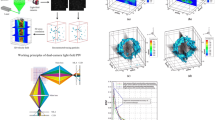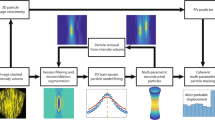Abstract
Defocusing digital particle image velocimetry (DDPIV), as a true three-dimensional (3D) measurement technique, allows for the measurement of 3D velocities within a volume. Initially designed using a single CCD and 3-pinhole mask (Willert and Gharib in Exp Fluids 12:353–358, 1992), it has evolved into a multi-camera system in order to overcome the limitations of image saturation due to multiple exposures of each particle. In order to still use a single camera and overcome this limitation, we have modified the original single CCD implementation by placing different color filters over each pinhole, thus color-coding each pinhole exposure, and using a 3-CCD color camera for image acquisition. Due to the pinhole mask, there exists the problem of a significant lack of illumination in a conventional lighting setup, which we have solved by backlighting the field-of-view and seeding the flow with black particles. This produces images with a white background superimposed with colored triple exposures of each particle. A color space linear transformation is used to allow for accurate identification of each pinhole exposure when the color filters’ spectrum does not match those of the 3-CCD color camera. Because the imaging is performed with a multi-element lens instead of a single-element lens, an effective pinhole separation, d e, is defined when using a pinhole mask within a multi-element lens. Calibration results of the system with and without fluid are performed and compared, and a correction of the effective pinhole separation, d e, due to refraction through multiple surfaces is proposed. Uncertainty analyses are also performed, and the technique is successfully applied to a buoyancy-driven flow, where a 3D velocity field is extracted.


















Similar content being viewed by others
References
Estevadeordal J, Goss L (2005) PIV with LED: particle shadow velocimetry (PSV), 43rd AIAA Aerospace Sciences Meeting and Exhibit, January 10–13, Reno, Nevada
Gharib M, Modarress D, Dabiri D, Pereira F, Taugwalder F (1998) Development and application of a defocusing three dimensional DPIV technique for the mapping of two-phase bubbly flows. In: Processings of 9th international symposium on applications of laser techniques to fluid mechanics. Instituto Superior Técnico, Lisbon, Portugal, 16.5.1–16.5.7
Kajitani L, Dabiri D (2005) A full three-dimensional characterization of defocusing digital particle image velocimetry. Meas Sci Technol 16:790–804
Pereira F, Gharib M (2002) Defocusing digital particle image velocimetry and the three-dimensional characterization of two-phase flows. Meas Sci Technol 13:683–694
Pereira F, Gharib M, Dabiri D, Modarress D (2000) Defocusing digital particle image velocimetry. A 3-component 3-dimensional DPIV measurement technique. Application to bubbly flows. Exp Fluids 29:S78-S84
Pereira F, Lu J, Castano-Graff E, Gharib M (2007) Microscale 3D flow mapping with μ DDPIV. Exp Fluids 42:589–599
Pratt WK (1991) Digital image processing. Wiley, New York
Willert CE, Gharib M (1992) Three-dimensional particle imaging with a single camera. Exp Fluids 12:353–358
Yoon SY, Kim KC (2006) 3D particle position and 3D velocity field measurement in a microvolume via the defocusing concept. Meas Sci Technol 17:2897–2905
Acknowledgments
We would like to thank professor Gamal Khalil from the UW Chemistry department for his help in dying the polystyrene particles. This work is supported by the National Institute of Health (SRS 20309/SAP 1004717).
Author information
Authors and Affiliations
Corresponding author
Rights and permissions
About this article
Cite this article
Tien, WH., Kartes, P., Yamasaki, T. et al. A color-coded backlighted defocusing digital particle image velocimetry system. Exp Fluids 44, 1015–1026 (2008). https://doi.org/10.1007/s00348-007-0457-1
Received:
Revised:
Accepted:
Published:
Issue Date:
DOI: https://doi.org/10.1007/s00348-007-0457-1




